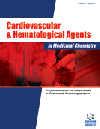- Home
- A-Z Publications
- Cardiovascular & Hematological Agents in Medicinal Chemistry (Formerly Current Medicinal Chemistry - Cardiovascular & Hematological Agents)
- Previous Issues
- Volume 9, Issue 4, 2011
Cardiovascular & Hematological Agents in Medicinal Chemistry (Formerly Current Medicinal Chemistry - Cardiovascular & Hematological Agents) - Volume 9, Issue 4, 2011
Volume 9, Issue 4, 2011
-
-
An update on the Management and Treatment of Deep Vein Thrombosis
More LessAuthors: D. Chattopadhyay, A. Al Samaraee and V. BhattacharyaDeep venous thrombosis (DVT) with its associated complications of pulmonary embolism and postthrombotic syndrome are an important cause of morbidity and mortality. This review article provides an overview of the pathophysiology, risk factors and the guidelines for thromboprophylaxis. It also reviews the available modalities in the diagnosis and treatment of DVT. The newer methods of treatment are also discussed.
-
-
-
The Effect of Chronic Co-Administration of Morphine and Verapamil on Isoproterenol-Induced Heart Injury
More LessObjective: Long-term co-administration of morphine and calcium channel antagonists (CCAs) is likely in some clinical conditions. Reciprocal interactions during chronic concomitant use of these agents are confirmed in central nervous system studies. However, there is little information regarding their chronic combination effects on the cardiovascular system. Present study was designed to assess the effects of chronic c Read More
-
-
-
Diabetic Cardiomyopathy and Oxidative Stress: Role of Antioxidants
More LessDiabetes has emerged as a major threat to worldwide health. The increasing incidence of diabetes in young individuals is particularly worrisome given that the disease is likely to evolve over a period of years. In 1972, the existence of a diabetic cardiomyopathy was proposed based on the experience with four adult diabetic patients who suffered from congestive heart failure in the absence of discernible coronary artery dis Read More
-
-
-
Drug-Drug Interactions Associated with Antiplatelet Therapy
More LessAuthors: Steven P. Dunn and Tracy E. MacaulayAntiplatelet therapy is of paramount importance in the treatment and prevention of adverse cardiovascular events and stroke. Drug-drug interactions (DDIs) among antiplatelet therapies have been growing in both prevalence and clinical importance. Most DDIs with antiplatelet therapies are pharmacodynamic in nature. DDIs with thienopyridines and proton pump inhibitors have resulted in advisories from regula Read More
-
-
-
The Blockade of Renin-Angiotensin-Aldosterone System in Hemodialysis Patients to Control Hypertension and Prevent Cardiovascular Disease: Optimal Pharmacotherapy
More LessAuthors: Yoshiyuki Morishita and Eiji KusanoCardiovascular disease (CVD) is the leading cause of morbidity and mortality in hemodialysis (HD) patients. Hypertension (HT) is a major risk factor for CVD. The renin-angiotensin-aldosterone system (RAAS) plays pivotal roles in the pathogenesis of HT in HD patients. Previous studies suggested that the blockade of RAAS may be effective to control blood pressure (BP) and to prevent CVD in HD patients. A certain level of preventi Read More
-
-
-
Current Approaches to Prevention of Contrast Induced Acute Kidney Injury
More LessAuthors: Jimena Blandon and Debabrata MukherjeeContrast-induced acute kidney injury is one of the leading causes of hospital-acquired acute kidney injury. Thus far, no strategies have been clearly shown to be effective in preventing contrast-induced acute kidney injury beyond thorough patient selection, meticulous hydration of the patient, and minimizing the amount of contrast used. Additional studies are needed to define the optimal means of hydration, role of commonly Read More
-
-
-
A Review of Oxidative Stress Related Genes and New Antioxidant Therapy in Diabetic Nephropathy
More LessAuthors: Jana Makuc and Danijel PetrovicA genetic component of diabetes and its complications (including diabetic nephropathy (DN)) is obvious, but the causative genes and mechanisms have not yet been satisfactorily identified. Oxidative stress is a single mechanism relating all major pathways responsible for diabetic damage. Numerous oxidative stress-related genes are positional candidates (determined by GWAS) and candidate genes studies confirm the asso Read More
-
-
-
Evaluation of a Standardized Protocol Using Lepirudin or Argatroban for Heparin-Induced Thrombocytopenia
More LessAuthors: Kenneth Kennedy, Doug Steinke, Shawn King, Kevin Poe, Jordan Reeves and Marintha ShortStudy Objective: To evaluate the effectiveness of our institution's heparin-induced thrombocytopenia (HIT) protocol in achieving a therapeutic activated partial thromboplastin time (aPTT) and to evaluate patient outcomes related to bleeding and thrombotic events before and after protocol implementation. Design: Retrospective, single-center, pre- and post- assessment of a protocol previously approved at our institution. Set Read More
-
-
-
Optimal Medical Therapy for Coronary Artery Disease in 2011- Perspectives from the STICH Trial
More LessAuthors: Thomas F. Whayne, Sibu P. Saha, Karla Quevedo and Debabrata MukherjeeMedical, percutaneous interventional, and surgical treatments for the management of coronary heart disease have progressed markedly during the past decade. There is evidence to suggest that for patients with stable coronary heart disease optimal medical therapy is equal in effectiveness for lowering the risk of major cardiovascular events, such as cardiovascular death, myocardial infarction, and stroke, as are revasculariz Read More
-
Volumes & issues
-
Volume 23 (2025)
-
Volume 22 (2024)
-
Volume 21 (2023)
-
Volume 20 (2022)
-
Volume 19 (2021)
-
Volume 18 (2020)
-
Volume 2 (2020)
-
Volume 17 (2019)
-
Volume 16 (2018)
-
Volume 15 (2017)
-
Volume 14 (2016)
-
Volume 13 (2015)
-
Volume 12 (2014)
-
Volume 11 (2013)
-
Volume 10 (2012)
-
Volume 9 (2011)
-
Volume 8 (2010)
-
Volume 7 (2009)
-
Volume 6 (2008)
-
Volume 5 (2007)
-
Volume 4 (2006)
Most Read This Month
Article
content/journals/chamc
Journal
10
5
false
en


